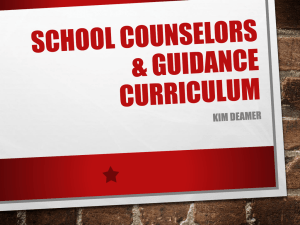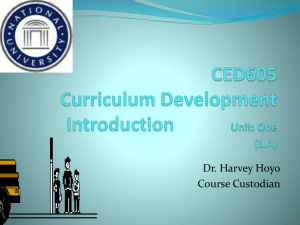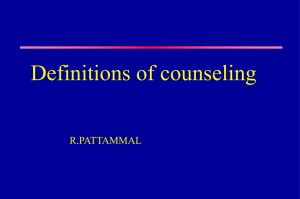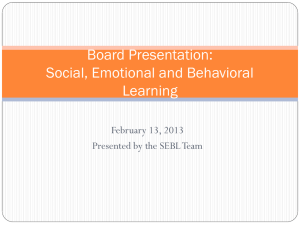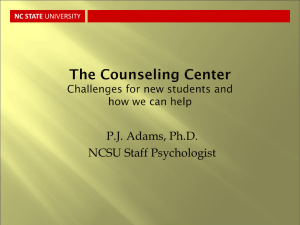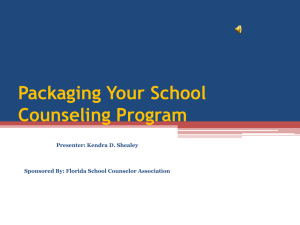Understanding the ASCA National Model for School
advertisement
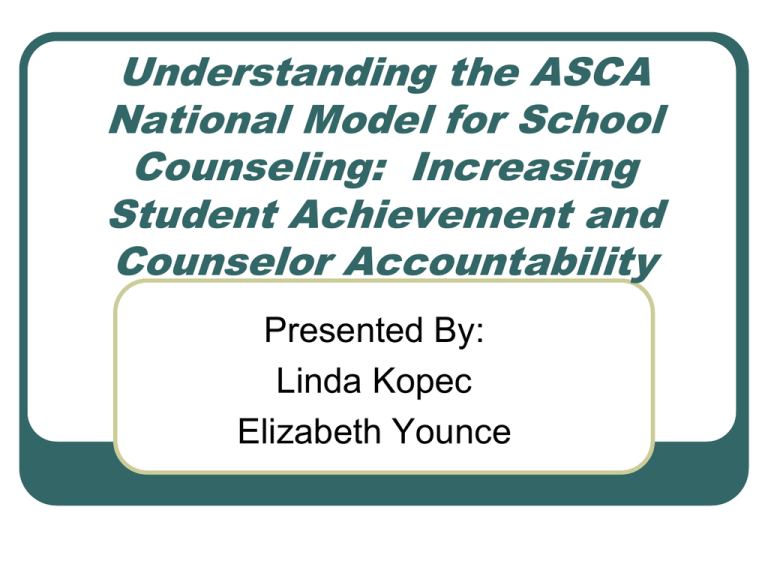
Understanding the ASCA National Model for School Counseling: Increasing Student Achievement and Counselor Accountability Presented By: Linda Kopec Elizabeth Younce OVERVIEW The American School Counselor Association (ASCA) collaborated to create a National Model for School Counseling Programs to connect school counseling with the current educational reform movements that emphasize student achievement and success. RATIONALE By aligning a school counseling program with the school/district mission and school improvement plan, school counselors: ….Partner as leaders in systemic change ….Ensure equity and access ….Promote academic, personal/social and career development for every student. Goals of School Counseling Program The ultimate goal of the school counseling program is to support the school’s academic mission. Ensuring academic achievement for every student includes counselor initiated activities designed to meet the needs of under-served, underperforming and under-represented populations. People have wondered…. WHAT DO SCHOOL COUNSELORS DO? Historical Problems in School Counseling Programs Lack of consistent identity Limited or no involvement in reform movements Variation in roles from state to state and site to site Non-school counselor responsibilities The ASCA National Model What is a school counseling program? • Prevention education • Developmental in nature • A collaborative effort • Driven by data • Integrated into the Total Educational Program • Academics, Career, Personal/Social Development Data Driven What are some of your current data sources? The old question was… What do counselors do? The new question is…. “HOW ARE STUDENTS DIFFERENT AS A RESULT OF THE SCHOOL COUNSELING PROGRAM?” From Entitlement…To Performance From a Program that: Focuses generally on the number of activities Measures the amount of effort Attends to the process of doing work Works to maintain the existing system From Entitlement…To Performance To A Program That: Focuses on outcomes and improved results Measures impact related to goals Attends to goals, objectives, and outcomes Changes and adapts to be more responsive From Entitlement…To Performance From counselors who: Focus on good intentions Talk about how hard they work Generally feel little need to change their behavior or approach From Entitlement…To Performance To Counselors Who: Focus on accomplishments Talk about effectiveness Know their future rests on accomplishments Communicate goals and objectives Implications What is the purpose of the school counseling program? What are the desired outcomes or results? What is being done to achieve those results? What evidence is there that the objectives have been met? Is the program making a difference? School Counseling Programs Are About: Counseling Leadership Assessment Technology Managing Resources Teaming Collaboration Data-Driven Decisions Advocacy School Counseling Programs Are About: RESULTS! HOW ARE STUDENTS DIFFERENT AS A RESULT OF THE SCHOOL COUNSELING PROGRAM? Comprehensive School Counseling A Comprehensive School Counseling program includes: • Program Planning • Individual and Group Counseling • Consulting (students, parents, teachers, • • • agencies) Coordinating Services Student Appraisal Professional Development ASCA National Model (p. 20) The ASCA National Model Addresses the Comprehensive School Program: • FOUNDATION • DELIVERY SYSTEM • MANAGEMENT SYSTEM • ACCOUNTABILITY SYSTEM • IMPLEMENTATION Themes Throughout the Model ADVOCACY LEADERSHIP COLLABORATION SYSTEMIC CHANGE FOUNDATION Beliefs and Philosophy Mission ASCA National Standards and Competencies Domains: Academic Development Career Development Personal/Social Development Beliefs and Philosophy We “agree statements • Guide the program development, • implementation and evaluation Require consensus from all personnel involved in the program Mission Statement Describes the program’s purpose Provides a vision of what every student should achieve Aligned with the school and district mission statements Standards from the National Model Standard 1: Program organization Standard 2: School guidance curriculum delivered to all students Standard 3: Individual student planning Standard 4: Responsive Services Standard 5: Systems support Standard 6: School counselor and administrator agreement Standards from the National Model, continued Standard 7: Advisory Council Standard 8: Use of data Standard 9: Student monitoring Standard 10: Use of time and calendar Standard 11: Results evaluation Standard 12: Program Audit Standard 13: Be a student advocate, leader, collaborator and systems change agent Delivery System School Guidance Curriculum Individual Student Planning Responsive Services System Support Guidance Curriculum Structured lessons delivered to all students Related to standards and competencies Integrated with academic curriculum Use data to develop lessons • • • • Environmental issues Discipline records Student records Standardized test scores Individual Student Planning Ongoing systemic activities Designed to assist students in establishing personal goals Designed to assist students in developing future plans Helps students get from point A to point B Counselor Planned and Directed Test score review, interpretation and analysis Promotion and retention information Career decision making Yearly course selection Test taking strategies Responsive Services Designed to meet students’ immediate needs Individual, group and crisis counseling Consultation, referral, mediation and information Available to all students and parents System Support Program management activities that establish, maintain, and enhance the program Professional development activities Consultation, collaboration and teaming Management System Agreements Advisory Council Use of Time Calendars Action Plans • • Guidance Curriculum Closing the Gap Use of Data • • Monitoring Student Progress Closing the Gap Agreements To ensure effective implementation of the program Based on delivery systems and needs Negotiated every year Advisory Council Group appointed to review the guidance program Counselor, administrator, teachers, parents, students, community members Use of Time Elementary Guidance Curriculum – 35 – 45% Individual Planning – 5 – 10% Responsive Services – 30 – 40% System Support – 10 – 15% Use of Time Middle School Guidance Curriculum – 25 – 35% Individual Planning – 15 – 25% Responsive Services – 30 – 40% System Support – 10 -15% Use of Time High School: Guidance Curriculum – 15 -25% Individual Planning – 25 – 35% Responsive Services – 25 – 35% System Support – 15 – 20% Calendars Master Calendar Weekly Calendar Published Ensures planned activities are completed PR Tool Action Plans Domain, standard and competency Description of activity Curriculum and materials to be used Time Allotment Person(s) responsible Evaluation of student success Expected result Action Plan Reflections Are your objectives measurable? Can you use data elements that are already being collected? Will the plan lead to results data? How will you measure? • Pre/post tests • Comparison to baseline data Use of Data Student Monitoring – collection, analysis and interpretation of data to ensure all students achieve academic success Closing the Gap – Use of disaggregated data which discerns the discrepancies between the desired results and the results currently being achieved How do Counselors Fit Into NO CHILD LEFT BEHIND? What can school counselors do to promote AYP, Closing the Gap, School Safety, etc.? • • • • Study skills and test-taking skills groups for lowperforming students Conflict Resolution Training Counseling students with suspension and absenteeism issues Staff training on behavior management and school climate Academic Results Interventions (Grades 6 – 8) After Academic Counseling Groups: 37% of 6th Graders (64) 24% of 7th Graders (47) 72% of 8th Graders (46) Demonstrated GPA Improvement Freshmen Promotion Incoming 9th grade students who had one or more D or F in the 8th grade were placed in a mentoring program with upperclassmen. 95% of participating students were promoted to the 10th grade, versus 80% of those outside of the program Academic Goal Setting After classroom guidance lessons prepost tests indicated… Student knowledge of goal setting increased from 10% to 90% 90% achieved their identified goal ACCOUNTABILITY Results Reports School counselor performance evaluations Program Audit Results Reports Data: Process Perception Results Over Time: Immediate, Intermediate, Long Range Results Reports – Impact over Time Personal/Social Results Conflict Resolution ( K – 5) Number of students who could peacefully resolve a conflict INCREASED from 55% to 88% Following implementation of a Conflict Manager program the number of suspended students was REDUCED from 13% in 97/98 to 3% in 01/02 Career Development (over 3 years) Scholarship dollars for students increased from $750,000 to $825,000 Parent attendance increased from 150 – 500 at guidance sponsored events Number of students visiting the career center increased from 30 to 200 daily Graduation rates increased from 84 – 89% What does an Audit tell us? Major strengths of the program Areas that need to be strengthened Categorizes the rate of progress of each criteria Helps to determine short and long range goals for improvement IMPLEMENTATION Administrator Support Planned Steps On-going Program Evaluation Steps to Implementation What if my school doesn’t want to change? Ask yourself… • What are my students’ needs? • What do I want to change? • What do I have the power to change? • What am I already doing that can be measured? • START SMALL and use that data to support further expansion and change Steps to Implementation 1. Planning the Program 2. Building Your Foundation 3. Designing the Delivery System 4. Implementing the Program 5. Making the Program Accountable Next Steps Review action plans Learn from experience Look at ways to implement new pieces of the National Model each year for 3 -5 years National Model Best Practices Start with what you can manage Align with school and district goals Define “at-risk” Data! Data! Data! Write measurable goals and objectives that are reasonable Write plans early, review them regularly Best Practices Understand the trends, work with the details Collaborate with others at your school Collaborate with other schools In Closing….. All this will not be finished in the first one hundred days. Nor will it be finished in the first thousand days, nor in the life of this administration, nor even perhaps in our lifetime on this planet. BUT LET US BEGIN. • John F. Kennedy And Finally…. “WE NEED TO BE THE CHANGE WE WANT TO SEE HAPPEN. WE ARE THE LEADERS WE HAVE BEEN WAITING FOR.” • Gandhi Questions?


